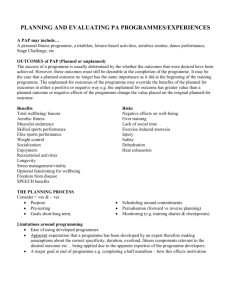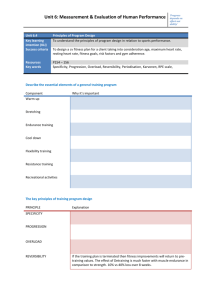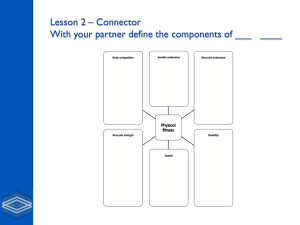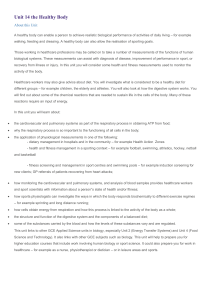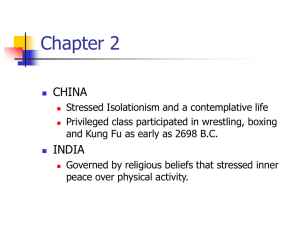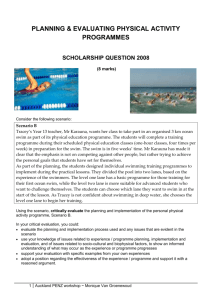PAP Information pack for students
advertisement
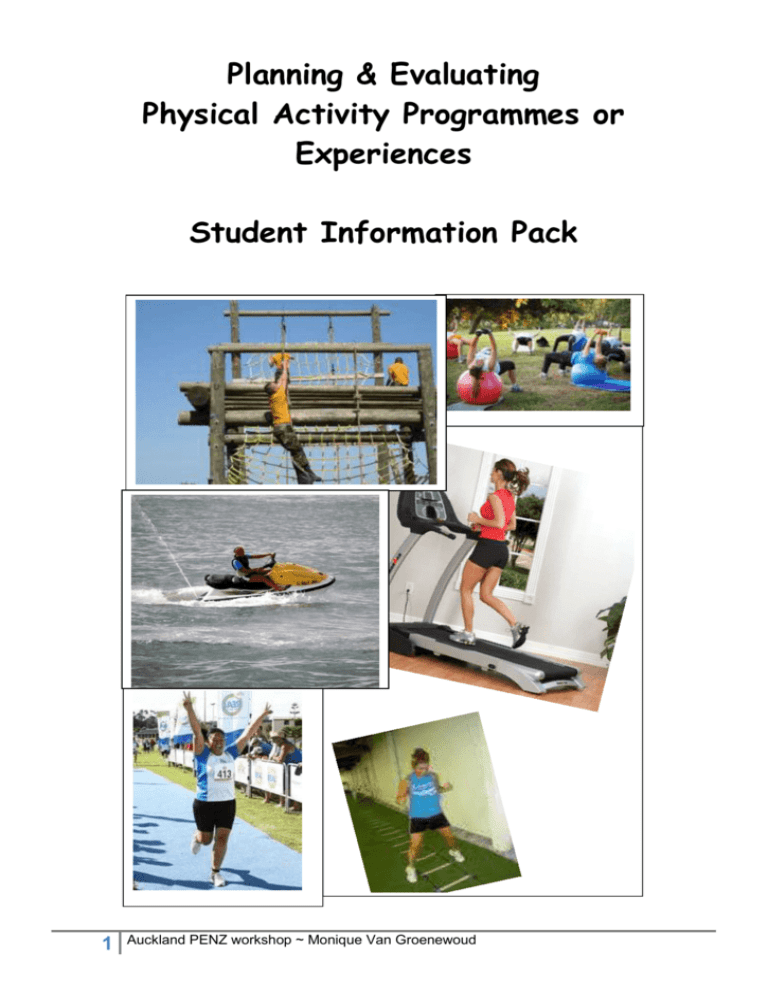
Planning & Evaluating Physical Activity Programmes or Experiences Student Information Pack 1 Auckland PENZ workshop ~ Monique Van Groenewoud PLANNING AND EVALUATING PA PROGRAMMES/EXPERIENCES A PAP may include… A personal fitness programme, a triathlon, leisure-based activities, aerobics routine, dance performance, Stage Challenge, etc PURPOSE Reasons/motives for participating Studies into reasons for participating have identified multiple possibilities i.e. Crandell (1980) found 17 categories of possible motives for participating in any activity and 6 groups of possible motives for sport: 1. Health and Fitness – maintaining well-being and high levels of fitness 2. Social – fun with friends, competing but not necessarily for winning 3. Ascetic – endurance, determination, and overcoming pain 4. Aesthetic – the beauty and grace of movement 5. Vertigo – thrill of speed and danger 6. Catharsis – to let of steam, release energy, emotion, tension, or frustration Other studies have placed motives on a continuum ranging from intrinsic motives to extrinsic motives e.g. Intrinsic Joy in movement Mastery & competence Excitement of the game Testing skills against others Extrinsic Looking good Winning? Social motives Payment Awards Grades Pleasing others THE PLANNING PROCESS Consider + ves & – ves Purpose Pre-testing (accuracy / validity) Goals short/long term (relevance) Scheduling around commitments Applying PoT’s & MoT’s especially FITT and specificity Periodisation (forward vs reverse planning) Monitoring (e.g. training diaries & checkpoints) Minimising barriers to participation OUTCOMES of PAP (Planned or unplanned) 1. The success of a programme is usually determined by the whether the outcomes that were desired have been achieved. However, these outcomes must still be desirable at the completion of the programme. 2. It may be the case that a planned outcome no longer has the same importance as it did at the beginning of the training programme. 3. The unplanned outcomes of the programme may override the benefits of the planned outcomes in either a positive or negative way e.g. the unplanned outcome has greater value than a planned outcome or negative effects of the programme change the value placed on the original planned outcome. 2 Auckland PENZ workshop ~ Monique Van Groenewoud POSSIBLE OUTCOMES of PAP (Planned or unplanned) Benefits Total wellbeing/ hauora Aerobic fitness Muscular endurance Skilled sports performance Elite sports performance Weight control Socialization Enjoyment Recreational activities Longevity Stress management/vitality Optional functioning for wellbeing Freedom from disease SPEECH benefits Risks Negative effects on well-being Over training Lack of social time Exercise induced anorexia Injury Safety Dehydration Heat exhaustion Lowered self-esteem Stress – emotional or psychological Lowered self-efficacy (feelings of competence) BIOPHYSICAL FACTORS Principle of Training Different applications develop different outcomes for PAP Specificity Intensity Frequency Duration Periodisation Tapering & Peaking Exercise Physiology Take into consideration: Energy systems Oxygen deficit / Oxygen debt Acute & chronic effects of exercise Individual physical differences Recovery / Fatigue Injury Methods of training Factors influencing performance / learning (Sports psychology) Motivation Arousal Principles of goal setting Relevance to self Other Limits to performance Genetic disposition Fitness vs skill Fitness Components Relevance to the individual Assessment – accuracy & relevance SOCIO-CULTURAL FACTORS Self-efficacy refers to an individual’s belief that he/she is competent at a particular task. Self-esteem influences feelings of self-efficacy. There is a strong relationship between level of confidence (selfefficacy) and starting or continuing to participate in a certain activity. Factors affecting participation BARRIERS/ENABLERS SPEECH influences (elaborate and be specific) Personal – age, gender, medical, psychological Behavioral – attitudes, values, expectations, motivations 3 Environmental – physical, social, Cultural, socio-economic, safety Personal identity, self-esteem and selfefficacy Adherence to programmes Emotional and psychological stress Impact of Physical Activity on Hauora Auckland PENZ workshop ~ Monique Van Groenewoud Planning & Evaluating Physical Activity Programmes Bigger Issues to consider Purpose Bio-Physical Aspects to consider Socio-cultural factors to consider Purpose e.g. Purpose e.g. The body as a project e.g. a focus on improving physical aspects One size fits all – who chose the activity? Bias – advantage & disadvantage (inequity and power relationships) Assumptions & stereotypes e.g. gender, masculinity / femininity / race The length of time available to achieve the intended aims Peaking for sports event vs maintaining performance over a season Skill acquisition vs fitness Improvement vs maintenance vs rehabilitation Diversity of Individual needs Diversity of desired outcomes Personal – diversity of reasons/motives for participating (e.g. Health & fitness, Social, Ascetic, Aesthetic, Vertigo, Catharsis) Diversity of Individual needs within a team sport or group situation Hauora vs Fitness / Physical aspects Recreation (maintaining active lifestyle) vs improvement Processes Processes e.g. Processes e.g. Expertise of the programme writer Generic (one size fits all) vs specific programmes Technocentricity – Body as a machine. A focus on scientific processes to improve its function. Scientism – only scientifically measurable aspects are valued Pre-testing - fitness testing of components of fitness or assessment of current performance (consider accuracy and validity of testing) Differences in physical attributes Limits to performance Genetic predisposition Goals short/long term (consider whether goals are SMARTER) Application of MoT’s & PoT’s (especially FITT and specificity) vs Motorskill learning Exercise physiology – training related energy systems Psychology skills training Periodisation & Peaking (forward vs reverse planning), Monitoring (e.g. training diaries & checkpoints) Safety considerations Recovery from injury Needs Analysis Hauora profile/analysis Minimising Barriers Enhancing Enablers Considering factors affecting participation e.g. Personal – age, gender, medical Behavioural – attitudes, values, expectations, adherence, perseverence Environmental – social & physical Psychological – personal identity, self esteem, self-efficacy, motivation, arousal S.P.E.E.C.H. influences (Societal, Political, Economic, Environmental, Cultural, Historical) Intrinsic vs extrinsic motivation Self efficacy & its effect on adherence to the programme Arousal and its affect on performance Logistical considerations e.g. scheduling around commitments Products e.g. Products e.g. Products e.g. Assumptions about the benefits of Physical Activity Perceived vs Real Risks of Physical Activity Intended & Unintended outcomes Changes in priorities e.g. the intended outcome is no longer important or the unplanned outcomes override the planned outcomes 4 Physiological Training effects - training effects on body systems & muscles - acute and chronic Overtraining Injury Exercise induced anorexia Heat exhaustion Aerobic fitness Muscular endurance Skilled sports performance Elite sports performance Weight control Longevity (i.e. lifespan) Freedom from disease Optimal functioning for wellbeing Evaluation of physical effects Evaluation of programme effectiveness to achieve physical goals Auckland PENZ workshop ~ Monique Van Groenewoud Effect on self esteem Effects on wellbeing / hauora Stress – Emotional and psychological Lowered self-efficacy (feelings of competence) Lack of social time Socialisation Enjoyment Stress management/vitality SPEECH benefits Evaluation of effects on wellbeing Evaluation of programme effectiveness to enhance wellbeing SPECIFC aspects to be critiqued 1. The effectiveness of a particular aspect of a programme e.g. planning process; pretesting, accuracy and validity of fitness testing, application of training principles; reverse planning vs forward planning when considering periodisation 2. The effectiveness of a programme for a particular: o Person e.g. individual needs in a team sport or group situation; individual differences / limitations; strengths/weaknesses; boredom/motivation; generic (one size fits all) vs specific (individualized) programmes o Purpose e.g. diversity of possible outcomes for PAP; specificity to an activity / playing position; suitability of activities; peaking for an event vs maintaining performance over a season; well-being vs sport; 3. The effectiveness of a programme to achieve outcomes e.g. +ves & -ves; benefits vs risks; outcomes of PAP on the 4 dimensions of wellbeing (Hauora); whether achieving intended outcomes is possible; impact on the individual; unexpected outcomes; fatigue, recovery, over-training; injury, illness, dehydration, heat exhaustion. 4. The effectiveness of programmes in general e.g. value of having a programme plan; the value of goal setting, impact on SPEECH; psychological benefits; social benefits; physical benefits; spiritual benefits Assumptions about bodies, health, fitness and athletes If you play sport, you must be fit. If you participate in physical activity, you must be fit. If you participate in physical activity, you are healthy. If you are thin, you are healthy. Fat or endomorph bodies are unhealthy. Healthy means physically healthy. Women’s sport is less skilful than men’s sport. Women’s sport is less important than men’s sport. Women’s sport is less exciting than men’s sport. Second place is first loser. Sport develops good character. Experts write fitness programmes that appear on the internet. 5 Auckland PENZ workshop ~ Monique Van Groenewoud TOOLS FOR CRITICAL ANALYSIS Consequences Societal Conditions Assumptions Social institutions: Family Economy Politics/Government Education Religion Sport Law Vested interest groups Fitness industry Diet industry Fashion industry Sport Media Consumer Culture Material from the media 1. Helps to form selfidentities 2. Establishes societal norms around body, image and lifestyle Social Constructs Sex Sexuality Gender Masculinity Femininity Body Image Race Religion Money Sport Attitudes Stereotypes Hegemony Attitudes Power Socialising Agents 1. people within the institution – peer group 2. the media – print, magazines, music, TV, videos, radio 6 Auckland PENZ workshop ~ Monique Van Groenewoud Healthism Scientism Technocentricity Body as a project Commodification POSSIBLE ISSUES for your critique Limitations to identify around programming Ease of using developed programmes – unlikely to cater for individual needs. “One Size Fits All” e.g. ease of using a single activity for a group OR ease of using a single programme for a group - lack of choice; does not cater for individual reasons for choosing an activity; does not cater for individual needs; can clash with personal priorities; activity lacks relevance to real life of participant; lack of adaptability to individual performance levels or needs; programme goal lacks relevance to individual (unrealistic expectations vs attainable goals) Assumptions to identify around programming Apparent expectation that an expert developed the programme, therefore making assumptions about the correct specificity, duration, overload, fitness components relevant to the desired outcome etc… being applied due to the apparent expertise of the programme developers. Healthism – the body needs to be kept in tune. Health is solely the responsibility of the individual. Healthism ignores SPEECH influences on individual health. The body as a project – appearance, size, shape, contents are potentially open to reconstruction Technocentricity – Scientific knowledge is required to test, fix and improve the body. Viewing the body as a machine ignores the impact of activity on self-esteem, identity and other aspects of Hauora. Also ignored are social pressure from others, the dynamics of the group, SPEECH influences, and psychological factors, as possible influences on participation. Scientism –valuable knowledge is that based on strict scientific method and measurable results. Commodification – a product that exists in order to make a profit e.g. consider how the fitness industry uses body image, exercise & sporting role models to sell their products Possible Sources of bias/stereotypes based on dominant social constructs Social constructs appear natural because the majority accepted these constructs as facts. However, these constructs evolve; they are not fixed. The key question pertinent for the critical thinker is “What if?” or view the world through fresh eyes by putting yourself into others shoes and telling their story (OPV’s). Bias/stereotypes associated with elite performance / endurance athletes / a particular body type e.g. a major goal at end of programme of completing a half marathon – how this effects motivation and adherence to the programme, for a beginner. How this matches with the experience, body composition and fitness of individuals. Cultural bias or stereotypes e.g. clothing requirements (skimpy bikinis for beach volley) or the nature of the activity may be predisposed to particular cultural groups because of social norms. Gender bias or stereotypes e.g. activities perceived as male/female, differentiation that may be based on gender, competing against the opposite sex where physical differences between genders may make a difference. Other sources of bias/stereotypes based on other social constructs – age, health status, physical ability, body image, race, religion, sexuality, feminism, masculinity, sex, morality Bias towards PA programmes based on physical fitness outcomes (body as a project) vs Hauora and holistic outcomes. Hegemony (Power relationships) – those in power resist change as they have a vested interest in maintaining power and therefore work to perpetuate the status quo of power imbalances. Less powerful groups have a stake in social change. Social institutions perpetuate the status quo of power imbalances e.g. government, education, business, media, religion, sport, law & justice. Key questions for critical thinkers are “Whose interest is being served?” “Who is disadvantaged?” “Why?” “Why not?” 7 Auckland PENZ workshop ~ Monique Van Groenewoud PLUSES – De Bono’s Yellow Hat = Positive view points A: PURPOSE Why is the purpose of this programme worthwhile? Why is the programme suitable to the participants? B: PROCESS What were other strengths of the programme? What good points were evident in the planning process (application of MoT’s & PoT’s, etc)? What factors affecting participation have been taken into consideration in the planning of this programme? What makes this programme feasible / workable? Why is this programme effective? C: OUTCOMES How will the programme benefit the participants? What positive outcomes were evident / possible? What are the benefits of the programme? Who benefits? Why is this programme worthwhile? MINUSES – De Bono’s Black Hat = Negative view points A: PURPOSE Why is the purpose of this programme NOT worthwhile? Why is the purpose of this programme NOT suitable to the participants? B: PROCESS What were other weaknesses of the programme? What gaps / limitations were evident in the planning process (application of MoT’s & PoT’s, etc)? What factors affecting participation HAVE NOT been taken into consideration in the planning of this programme? What makes this programme problematic? Why is the programme problematic? C: OUTCOMES How could the programme be harmful to participants? What negative influences could the programme have on the participant? What are the risks of the programme? Who is most vulnerable / at risk? Why is this programme not worthwhile? SEDEC – De Bono’s White Hat = Facts 8 Integrate knowledge Support judgments with examples from own experience or the given information Auckland PENZ workshop ~ Monique Van Groenewoud Issues around Assumptions, Bias & Limitations De Bono’s Red Hat (Emotions and Feelings) 1. Refer to the critical thinking material. 2. Discuss at least one major issue within your essay. 3. Prepare a strong critique of this issue, looking at it from a range of views. SOLUTIONS - De Bono’s Green Hat (Creativity) Focus on significant problems … 1. What can be done to solve the big issues? a. Brainstorm ideas to address the major issues you identified. b. Give consideration for why this might or might not work i.e. do a PMI of each possibility. 2. What are the alternatives/new ideas needed to further enhance the programme (think - purpose, process, outcomes)? CONCLUSIONS - De Bono’s Blue Hat (Metacognition) 1. Adopt a position on the key question of the critical evaluation? Where would you place yourself on the continuum of ‘Yes’ to ‘No’ (but not at the ends of the continuum)? 2. Identify the 2 most significant points (already presented in your essay) to back up your position. Share these 2 points with those near you on the continuum. 9 Auckland PENZ workshop ~ Monique Van Groenewoud Website Links to related articles From Brian MAC Sports Coach … Links to articles on Planning Training: http://www.brianmac.co.uk/articles/tindexpla.htm Developing Personal Exercise Programmes: http://www.brianmac.co.uk/pep.htm Goalsetting: http://www.brianmac.co.uk/articles/scni19a1.htm How to develop a programme: http://www.brianmac.co.uk/articles/scni27a6.htm Planning guidelines: http://www.brianmac.co.uk/articles/scni3a1.htm Programme Planning Steps: http://www.brianmac.co.uk/plant.htm Periodisation: http://www.brianmac.co.uk/articles/scni19a2.htm Periodisation – Myth or reality: http://www.brianmac.co.uk/articles/article012.htm The importance of rest: http://www.brianmac.co.uk/articles/article020.htm FITT principles & injury prevention: http://www.brianmac.co.uk/articles/scni15a1.htm Planning for Strength training: http://www.brianmac.co.uk/articles/scni11a6.htm Tapering for success: http://www.brianmac.co.uk/articles/scni7a2.htm Peaking: http://www.brianmac.co.uk/articles/scni3a2.htm Planning training for soccer teams: http://www.brianmac.co.uk/football/footballplan.htm What the experts say: Nigel Hetherington reviews the latest research material relating to coaching, exercise physiology and athletic development e.g. http://www.brianmac.co.uk/articles/scni15a8.htm Planning for success Planning around goals Monitoring and Evaluation Allowing for recovery Flexibility and when not to do it Feeling better may be the key recovery parameter http://www.brianmac.co.uk/articles/scni35a10.htm#g Process and outcome goals work best Exercise Risks Exercise and the heat: http://ezinearticles.com/?Beat-the-Heat&id=1390888 Shin Splints: http://ezinearticles.com/?Defeating-Shin-Splints&id=1390927 Exercise Benefits Benefits of exercise programmes: http://www.balanceforlife.co.nz/corporatesolutions.html Nutrition Vegetarians can reach gold medals: http://ezinearticles.com/?Vegetarian-Athletes---10-OlympicChampions&id=1401638 10 Auckland PENZ workshop ~ Monique Van Groenewoud Website Links to related articles (continued) Training Methods Interval training vs Continuous Tempo training (Peter Snell Research) http://www.runnersweb.com/running/rw_news_frameset.html?http://www.runnersweb.com/running/news/rw_ne ws_20070227_RRN_Interval.html Periodisation The Principles Of Periodization By Owen Anderson, Ph. D. - Copyright © 2002-2004: http://www.runnersweb.com/running/rw_news_frameset.html?http://www.runnersweb.com/running/ne ws/rw_news_20041224_RRN_Periodization.html Principles Of Periodization By ©2000 - 2006 David Edell: http://www.athleticadvisor.com/Weight_Room/periodizaton.htm Periodisation for cycling: http://www.peakscoachinggroup.com/freeinfo/periodization_part1.html http://www.peakscoachinggroup.com/freeinfo/periodization_part2.html Periodisation for triathletes: http://www.peakscoachinggroup.com/freeinfo/periodiazatio_for_peak_performance.html Block periodisation vs traditional periodisation: http://www.ncbi.nlm.nih.gov/pubmed/18212712 Arthur Lydiard’s ideas on periodisation: http://en.wikipedia.org/wiki/Arthur_Lydiard Periodisation & Over-training: http://www.peakscoachinggroup.com/freeinfo/The_underperformance_syndrome.html Critics of Periodization: THE END OF “PERIODIZATION” IN THE TRAINING OF HIGH PERFORMANCE SPORT By Yuri Verhoshansky http://www.athleticscoaching.ca/UserFiles/File/Sport%20Science/Planning%20&%20Periodization/Ge neral%20Concepts/Verhoshansky%20The%20End%20of%20Periodization.pdf Peak When It Counts author Bill Freeman. Here is his rebuttal to Yuri Verhoshansky: http://www.trackandfieldnews.com/technique/149_William_Freeman.pdf Mel C Siff, PhD on the criticisms of periodisation: http://www.performbetter.com/catalog/matriarch/OnePiecePage.asp_Q_PageID_E_82_A_PageName_ E_ArticleSiffPeriodization Criticism of Periodisation - Team Sports vs Individual Sports by John Shepherd: http://www.runnersweb.com/running/rw_news_frameset.html?http://www.runnersweb.com/running/ne ws/rw_news_20050811_PPO_Periodisation.html 11 Auckland PENZ workshop ~ Monique Van Groenewoud
